Kubbeh is a traditional Levantine dish, prepared in various ways in different places, but in most cases it is a semolina dumpling recipe with a distinctive hint of cardamom (from the Baharat spice), passed from generation to generation, here is a great vegan heirloom recipe.
Today i decided to use a traditional Kurdish recipe of Kubbeh in a thick hearty beet soup. I first ate this as a kid, when our house keeper would sometimes make lunch for us when both of my parents were busy working long hours. Many years later, i walked into my folks house, where the TV was showing the US invasion of Iraq, the same house keeper was there and was staring at the TV, and told me she recognizes the street in Mosul where she grew up.
This style of Kubbeh is a bit labor intensive, but the rewards are incredible and totally worth the effort. Making the actual Kubbeh dumpling is sometimes called “rolling” Kubbeh.
Preparing Kubbeh is divided in to three main parts (and the ingredients needed for each part, see note about ingredients at the end):
(***This recipe will make about 25-30 dumplings, which is enough for 8 hungry adults. You can simply half the amounts if you want to make a smaller amount, but dont skimp on the baharat, salt, pepper or garlic, and you will still want to make a large pot of soup, regardless of how many dumplings you make, so leave the soup quantities the same.)
The Stuffing:
- 3 Tbsp of Earth balance (or other vegan “butter”)
- 3 large onions, chopped
- 1 pack of “Smart Ground” (or any other meat substitute) of about 1Lb (400g) (if no using smart ground make sure you substitute is chopped into small chunks)
- 1 clove of garlic finely chopped or pressed through a garlic press
- 1 bunch of fresh parsley finely chopped (you can use the stems as well if they are clean and fresh)
- 3-4 large white mushrooms
- 1 Tsp of Baharat
- Salt, pepper to taste
The dough:
- 500g of semolina (about 1.2Lb)
- 1 Tsp salt
- 1-1.5 cups of warm water
The Soup:
- Olive oil
- 3 beets, peeled, and sliced into thin slices
- 5 Tbsp Tomato paste
- 6-8 cups of water
- Salt/pepper to taste
In a nut shell, you will cook the stuffing, roll it into the dough to form small balls and dump them into a boiling soup pot.
The stuffing: (***You will want to start the stuffing ahead of time, to give it sufficient time to cool off before you start “rolling” the dumplings)
Heat up a large sauce pan or medium pot, and add the Earth balance (or other butter substitute). Let the butter substitute heat up, you will know its hot enough when you throw a piece of onion in and it begins to sizzle. Add the chopped onions and stir well until the onions begin to brown up.
“Smart Ground” is the ideal thing to use for this recipe (the smart life sausage stuff works well too). If you will be using “Smart Ground”, make a cut on the side of the vacuum sealed pack with a sharp knife. This will help you crumble the contents without making a huge mess. Otherwise add your chopped meat substitute in and mix it in with the onions. After adding all the meat substitute continue stirring for another 5 minutes on high heat. Add the chopped mushrooms, garlic, salt and pepper and stir for another 5 minutes, still on high heat, then move the stuffing to a mixing bowl for the next step. Add the Baharat and chopped parsley and mix well. Cover the bowl with a plastic wrap and let it cool down, you want it to cool down enough for you to stick your fingers in it without hurting yourself. You can put it in the fridge if you are pressed for time.
The Soup: (***You want to get the soup going so it is ready and boiling before you drop the first dumpling in)
In a large pot, heat up some olive oil and lightly start browning the beet slices. Add the tomato paste, salt and pepper and mix well (“don’t let the sauce stick…”), while stirring, add the water and let the whole thing boil. Once the soup has boiled, turn the heat down and leave it simmering, it is now ready for the dumplings.
The dough: (***The semolina dough is a fluffy and light mix, that must be prepared fairly close the time of making the dumplings. It dries out fast, and will become thick and heavy if worked or kneaded for too hard or too long. It only takes a minute to mix the dough so the trick is to make just enough, and right when you are ready to roll, you can always mix another small batch of dough if needed)
Pour the semolina and salt into a large mixing bowl, and slowly add warm water, while gently stirring with a fork. The semolina will clump up, which is fine. Continue adding the water while stirring until everything is clumped up (***you may need slightly more or less water then indicated depending on your semolina so add slowly). Its time to get your hands dirty – stick your fingers in there and gently work the mixture into a smooth and sticky dough, add more water or semolina as needed. Be careful not to work the dough to hard, or press it is like you would with bread dough, it will just compact it and make it harder to work with. If it is too sticky, you can add a pinch of semolina and gently work it in.
Rolling Kubbeh (making the dumplings): This is a bit tricky at first, but once you get a hang of it should become very easy.
- Make a ball: Tear off a piece of dough, about the size of a large walnut. Lightly wet one hand, and roll the piece into a small ball.
- Open it up: Hold the ball in the palm of one hand and wet the thumb of the other. Press in to the ball, and use your palm to create a little “bowl” or “cup” shape.
- Stuff it: Scoop up some of the stuffing and press it to the cup.
- Close it: Starting with one side, stretch the edge of the wall of the cup over the stuffing, and pinch it together with the wall on the opposite side. Do this slowly and carefully so as not to rip or over stretch the dough. You can push in the stuffing while you do this to help make some more area to pinch. Repeat the process until the hole is sealed (its totally ok to add a thin small tear of dough fr to patch up any holes, use a wet finger to do this frankenkubbeh move).
Dump it: Put the ready Kubbeh onto a wooden spoon and gently lower it into the simmering soup, and give it a stir after 2-3 seconds to make sure it does not stick to the bottom, in a few minutes the semolina will solidify, so by the time you add the next one it will be safe to stir the pot again.
Some rolling tips:
- You can make the Kubbeh big or small
- Use about a spoonful of stuffing for each Kubbeh, you can add more if there is room
- Keep rim of the dough “cup” clear of stuffing, the oily residue will make it harder to close
- After stuffing the cup wash and dry your free hand to get rid of the stuffing oil, it will help closing the Kubbeh in to a nice roundish ball (i keep a towel hanging over my shoulder so i can dry my hands anytime).
Wait: After all the Kubbeh have been dumped into the pot, let the whole thing simmer for an additional 15-20 minutes, while giving a gentle stir half way through.
Eat!: The Kubbeh is best eaten when it’s steaming hot. Serve 2-3 Kubbeh balls in a bowl with plenty of soup. Cut the Kubbeh in half and let it soak in the soup for a second before enjoying it.
Kubbeh refrigerates nicely, and you can reheat it in the microwave for a great leftovers lunch or dinner the next day.
A note on ingredients:
- Baharat: basically all you need is a mixture of cardamom and cummin, but any Baharat mix with cardomom will do. Most middle eastern markets in the US have this spice, and there is none locally, just get it online.
- Tomato paste: Use the best possible paste here, as this will impact the taste of the whole dish.
- Semolina: Found in most middle eastern markets, and in some supermarkets too, before their demise, most Dominick’s used to carry this.
- Meat substitute: I have found that Lifelight/Smart life meat substitutes work best, the “Smart Ground” is the absolute best and easiest to use in this particular case, but any will work, the more neutral the starting taste of the substitute the better it will lend itself to the other flavors in this dish.
Text copyright 2014 by Anselmo Di Medici. All photos copyright 2014 by Tess Scheflan No part of the text or photos may be used without explicit written permission.
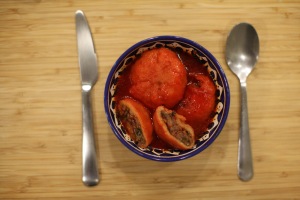
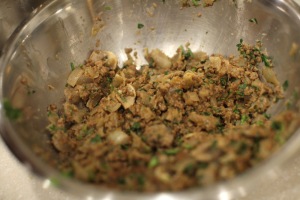
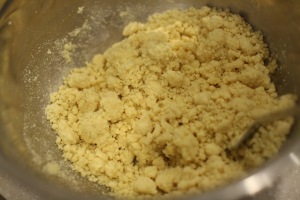
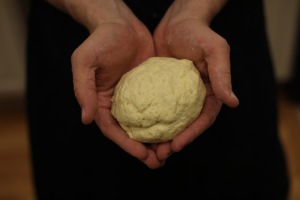
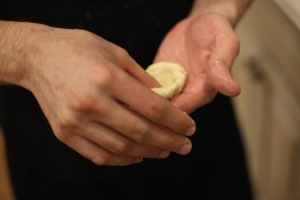
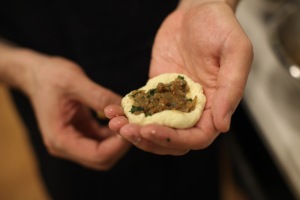
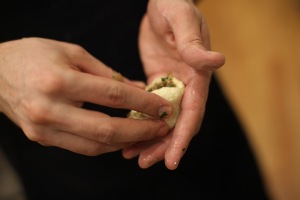
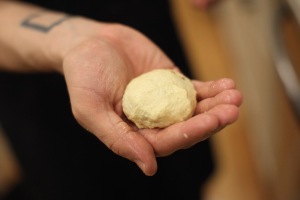
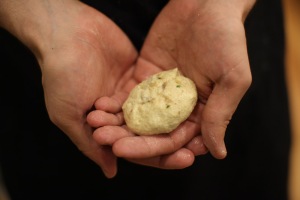
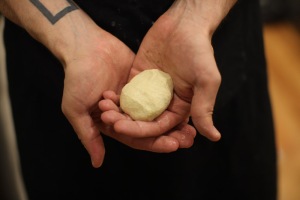
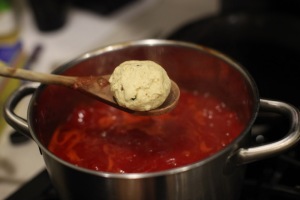
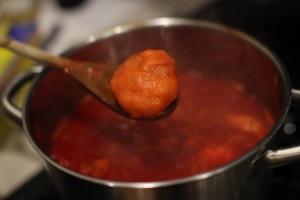
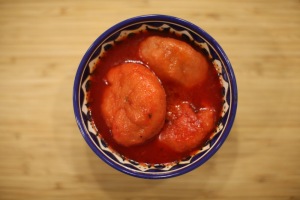
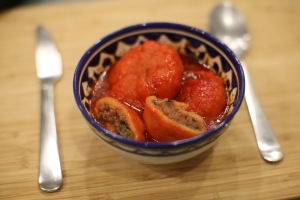
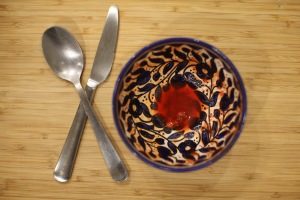



Very nice and it sounds and looks delicious, but I guess you have to be really motivated to do all that work.
It really sounds like a lot more work then it actually is, and – its lots of fun!
We make Kubbeh often (not vegan), it only seems that a lot of work, but it’s not, and it’s worth every minute
Pingback: Kubbeh: Hamusta | Vegan Orientalism